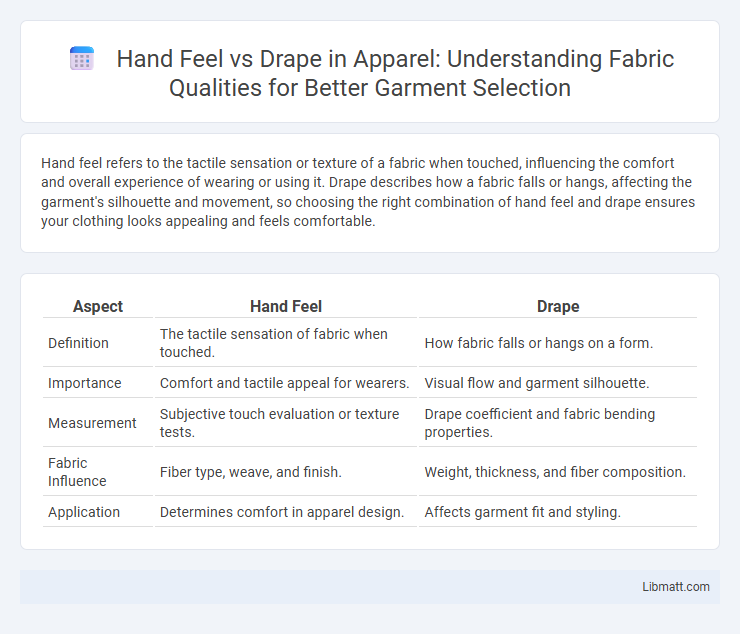Hand feel refers to the tactile sensation or texture of a fabric when touched, influencing the comfort and overall experience of wearing or using it. Drape describes how a fabric falls or hangs, affecting the garment's silhouette and movement, so choosing the right combination of hand feel and drape ensures your clothing looks appealing and feels comfortable.
Table of Comparison
| Aspect | Hand Feel | Drape |
|---|---|---|
| Definition | The tactile sensation of fabric when touched. | How fabric falls or hangs on a form. |
| Importance | Comfort and tactile appeal for wearers. | Visual flow and garment silhouette. |
| Measurement | Subjective touch evaluation or texture tests. | Drape coefficient and fabric bending properties. |
| Fabric Influence | Fiber type, weave, and finish. | Weight, thickness, and fiber composition. |
| Application | Determines comfort in apparel design. | Affects garment fit and styling. |
Understanding Hand Feel in Textiles
Hand feel in textiles refers to the tactile sensation experienced when you touch or handle a fabric, encompassing attributes like softness, smoothness, stiffness, and texture. It plays a crucial role in determining the overall comfort and usability of a material, influencing how it interacts with your skin and the environment. Understanding hand feel complements the study of drape, which describes how a fabric hangs and flows, helping you select textiles that balance tactile appeal with desired garment movement.
Defining Drape: What It Means in Fabric
Drape refers to how fabric falls or hangs when shaped by gravity or movement, influencing the garment's overall appearance and fit. Unlike hand feel, which describes the tactile sensation against your skin, drape emphasizes the visual fluidity and structure of the material. Understanding drape helps you choose fabrics that complement your design goals, whether you prefer stiff, structured looks or soft, flowing silhouettes.
Key Differences Between Hand Feel and Drape
Hand feel refers to the tactile sensation or texture of a fabric when touched, indicating softness, smoothness, or roughness. Drape describes how a fabric hangs or flows over a surface, measuring its flexibility and weight distribution in motion. Understanding these key differences helps you select textiles that balance comfort with aesthetic fluidity in garment design.
Factors Influencing Fabric Hand Feel
Fabric hand feel is influenced by fiber type, yarn structure, and finishing processes that determine softness, smoothness, and flexibility. The weave or knit method affects texture and weight, shaping how the fabric responds to touch and movement. Chemical treatments and mechanical finishing, such as calendaring or brushing, enhance tactile qualities and overall comfort perception.
Elements Affecting Fabric Drape
Fabric drape is primarily influenced by fiber type, yarn structure, and fabric construction, which collectively determine the material's flexibility and weight distribution. Hand feel, encompassing softness and texture, interacts with drape by affecting how the fabric conforms to shapes and moves fluidly. Variations in fiber fineness, yarn twist, and weave tightness significantly impact drape, making these elements critical for optimizing fabric performance in apparel and upholstery.
Importance of Hand Feel in Garment Selection
Hand feel plays a crucial role in your garment selection as it directly influences comfort and tactile satisfaction. Fabrics with a soft, smooth hand feel often indicate higher quality and better wearability, making the garment more appealing for extended use. The drape complements hand feel by affecting how the fabric hangs and moves on the body, but hand feel remains key to your sensory experience and overall garment comfort.
Role of Drape in Fashion Design
Drape plays a crucial role in fashion design by determining how fabric shapes and flows around the body, enhancing the garment's silhouette and overall aesthetic appeal. The hand feel, or tactile quality of the fabric, influences the drape by affecting softness, weight, and flexibility, which in turn impacts movement and comfort. Designers prioritize drape to create visually dynamic and functional clothing that flatters different body types while aligning with current style trends.
Measuring Hand Feel and Drape in Textiles
Measuring hand feel in textiles involves evaluating the fabric's softness, smoothness, and flexibility through tactile assessment and instruments like the Kawabata Evaluation System. Drape is quantified by analyzing how fabric bends and folds, often using drape meters or visual scoring methods to determine the silhouette it creates when suspended. Your choice of fabric should balance hand feel and drape measurements to ensure comfort and aesthetic performance in the final product.
How Fabric Composition Impacts Hand Feel vs. Drape
Fabric composition significantly influences both hand feel and drape, as natural fibers like cotton offer a soft, breathable texture with moderate drape, while synthetic fibers such as polyester provide a smoother hand feel but often result in stiffer drape. Blends of fibers can optimize these properties, enhancing the fabric's flexibility and smoothness to better conform to your body's movements. Understanding the specific blend and fiber content helps predict how a fabric will feel against the skin and how it falls in garments.
Tips for Choosing Fabrics Based on Hand Feel and Drape
When selecting fabrics, prioritize hand feel by gently compressing the material to assess softness, texture, and flexibility, ensuring comfort and usability for your project. Evaluate drape by allowing the fabric to hang naturally; fabrics with fluid drape like silk or jersey conform smoothly to shapes, while stiffer materials like canvas maintain structure. Consider the end garment or decor purpose to balance hand feel and drape, choosing softer fabrics for flowing silhouettes and stiffer options for tailored or structured designs.
hand feel vs drape Infographic

 libmatt.com
libmatt.com